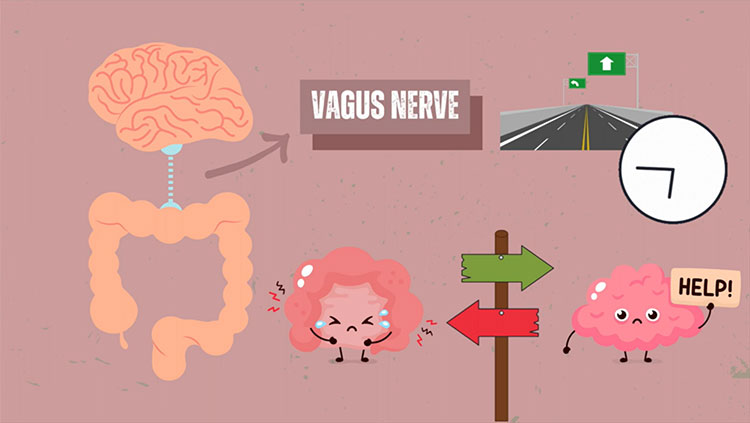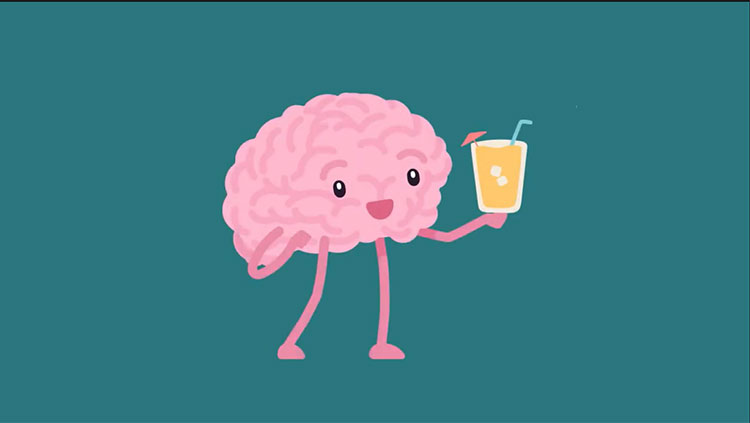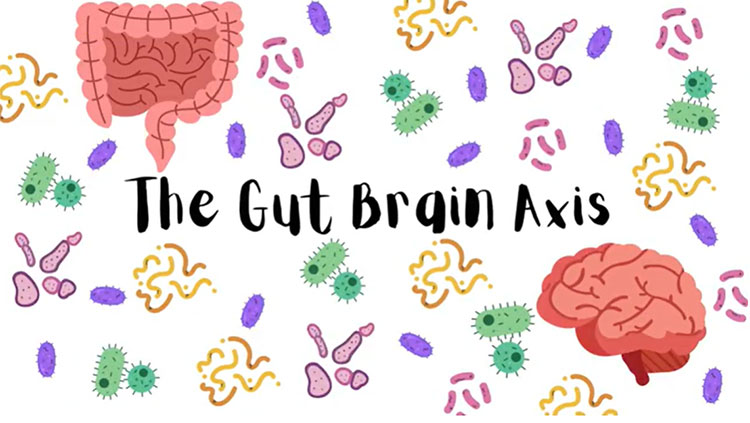How Stress Impacts the Brain and Body
- Reviewed28 Oct 2022
- Author Diane A. Kelly
- Source BrainFacts/SfN

Your body is in a typecast role when it responds to threats. You breathe faster, your heartbeat speeds up, your muscles tense and prepare for action. These reactions may have helped our ancestors run from predators, but any stressful situation — arguing with your parents, a blind date, a looming deadline at work, abdominal cramps, discovering your apartment was robbed, trying karaoke for the first time — has the potential to set them off. Scientists call this reaction the stress response, and your body turns it on to some degree in response to any external or internal threat to homeostasis.
The Stress Response
The stress response weaves together three of the brain’s parallel communication systems, coordinating the activity of voluntary and involuntary nervous systems, muscles, and metabolism to achieve one defensive goal.
Messages sent to muscles through the somatic (voluntary) nervous system prime the body to fight or run from danger (the fight-or-flight response). Messages sent through the autonomic (involuntary) nervous system redirect nutrients and oxygen to those muscles. The sympathetic branch tells the adrenal medulla to release the hormone epinephrine (also called adrenaline), which makes the heart pump faster and relaxes the arterial walls that supply muscles with blood so they can respond more quickly.
At the same time, the autonomic system’s parasympathetic branch restricts blood flow to other organs including the skin, gonads, digestive tract, and kidneys. Finally, a cascade of neuroendocrine hormones originating in the hypothalamus and anterior pituitary circulates in the bloodstream, affecting processes like metabolic rate and sexual function, and telling the adrenal cortex to release glucocorticoid hormones — like cortisol — into the blood.
Glucocorticoid hormones bind to many body tissues and produce widespread effects that prepare the body to respond to potential threat. These hormones stimulate the production and release of sugar from storage sites such as the liver, making energy available to muscles. They also bind to brain areas that ramp up attention and learning. And they help inhibit nonessential functions like growth and immune responses until the crisis ends.
It’s easy to imagine how (and why) these physiological changes make your body alert and ready for action. But when it comes to stress, your body can’t tell the difference between the danger of facing down a bull elephant and the frustration of being stuck in traffic. When stress is chronic, whatever its cause, your adrenal glands keep pumping out epinephrine and glucocorticoids. Many animal and human studies have shown that long-term exposure to these hormones can be detrimental.
Chronic Stress
Overexposure to glucocorticoids can damage a wide range of physiological systems. It can cause muscles to atrophy, push the body to store energy as fat, and keep blood sugar levels abnormally high — all of which can worsen the symptoms of diabetes. Overexposure to glucocorticoids also contributes to the development of hypertension (high blood pressure) and atherosclerosis (hardening of the arteries), increasing the risk of heart attacks. Because the hormones inhibit immune system function, they also reduce resistance to infection and inflammation, sometimes pushing the immune system to attack the body’s own tissues.
Chronic stress can also have specific negative effects on brain tissue and function. Persistently high levels of glucocorticoids inhibit neuron growth inside the hippocampus, impairing the normal processes of memory formation and recall. Stress hormones can also suppress neural pathways that are normally active in decision-making and cognition, and accelerate the deterioration in brain function caused by aging. They may worsen the damage caused by a stroke. And they can lead to sleep disorders — cortisol is also an important wakeful signal in the brain, so high cortisol levels due to chronic stress may delay sleep. Stress-induced insomnia can then start a vicious cycle, as the stress of sleep deprivation leads to the release of even more glucocorticoids.
The effects of chronic stress may even extend beyond a single individual because glucocorticoids play important roles in brain development. If a pregnant woman suffers from chronic stress, the elevated stress hormones can cross the placenta and shift the developmental trajectory of her fetus. Glucocorticoids are transcription factors, which can bind to DNA and modify which genes will be expressed as proteins. Studies with animal models have shown that mothers with high blood levels of glucocorticoids during pregnancy often have babies with lower birth weights, developmental delays, and more sensitive stress responses throughout their lives.
Because metabolic stressors such as starvation induce high glucocorticoid levels, it’s been suggested that these hormones might help prepare the fetus for the environment it will be born into. Tough, stressful environments push fetuses to develop stress-sensitive “thrifty” metabolisms that store fat easily. Unfortunately, these stress-sensitive metabolisms increase a person’s risk of developing chronic metabolic diseases like obesity or diabetes, especially if they subsequently grow up in lower-stress environments with plentiful food.
The effects of stress can even be passed to subsequent generations by epigenetic mechanisms. Chronic stress can change the markers on DNA molecules that indicate which of the genes in a cell are expressed and which are silenced. Some animal studies indicate that when changes in markers occur in cells that develop into eggs or sperm, these changes can be passed on and expressed in the animal’s offspring. Further research might reveal whether chronic stress has similar effects in humans, and whether inheriting silenced or activated genes contributes to family histories of cancer, obesity, cardiovascular, psychiatric, or neurodevelopmental disease.
Adapted from the 8th edition of Brain Facts by Diane A. Kelly.
CONTENT PROVIDED BY
BrainFacts/SfN
References
Aguilera, G. (2011). HPA axis responsiveness to stress: Implications for healthy aging. Experimental Gerontology, 46(2-3), 90–95. https://doi.org/10.1016/j.exger.2010.08.023
Balkaya, M., Prinz, V., Custodis, F., Gertz, K., Kronenberg, G., Kroeber, J., Fink, K., Plehm, R., Gass, P., Laufs, U., & Endres, M. (2011). Stress worsens endothelial function and ischemic stroke via glucocorticoids. Stroke, 42(11), 3258–3264. https://pubmed.ncbi.nlm.nih.gov/21921276/
Carpenter, R., Reddi, B. 2012. Neurophysiology: A Conceptual Approach, Fifth Edition. Hodder Arnold: London.
Costello, R. B., Lentino, C. V., Boyd, C. C., O'Connell, M. L., Crawford, C. C., Sprengel, M. L., & Deuster, P. A. (2014). The effectiveness of melatonin for promoting healthy sleep: a rapid evidence assessment of the literature. Nutrition Journal, 13, 106. https://doi.org/10.1186/1475-2891-13-106
Debono, M., Ghobadi, C., Rostami-Hodjegan, A., Huatan, H., Campbell, M. J., Newell-Price, J., Darzy, K., Merke, D. P., Arlt, W., & Ross, R. J. (2009). Modified-Release Hydrocortisone to Provide Circadian Cortisol Profiles. The Journal of Clinical Endocrinology & Metabolism, 94(5), 1548–1554. https://doi.org/10.1210/jc.2008-2380
Dulac, C. (2010). Brain function and chromatin plasticity. Nature, 465(7299), 728–735. https://doi.org/10.1038/nature09231
Fain, G.L., & O’Dell, T. J. 2014. Molecular and Cellular Physiology of Neurons, Second Edition. Harvard University Press: Cambridge.
Gu, H. F., Tang, C. K., & Yang, Y. Z. (2012). Psychological stress, immune response, and atherosclerosis. Atherosclerosis, 223(1), 69–77. https://doi.org/10.1016/j.atherosclerosis.2012.01.021
Harris, A., & Seckl, J. (2011). Glucocorticoids, prenatal stress and the programming of disease. Hormones and Behavior, 59(3), 279–289. https://doi.org/10.1016/j.yhbeh.2010.06.007
Hasan, K. M., Rahman, M. S., Arif, K. M., & Sobhani, M. E. (2012). Psychological stress and aging: role of glucocorticoids (GCs). Age (Dordrecht, Netherlands), 34(6), 1421–1433. https://doi.org/10.1007/s11357-011-9319-0
Houben, T., Coomans, C. P., & Meijer, J. H. (2014). Regulation of Circadian and Acute Activity Levels by the Murine Suprachiasmatic Nuclei. PLOS ONE, 9(10), e110172. https://doi.org/10.1371/journal.pone.0110172
Klok, M. D., Jakobsdottir, S., Drent, M. L. (2007). The role of leptin and ghrelin in the regulation of food intake and body weight in humans: a review. Obesity Reviews, 8(1), 21–34. https://pubmed.ncbi.nlm.nih.gov/17212793/
Peschel, N., & Helfrich-Förster, C. (2011). Setting the clock – by nature: Circadian rhythm in the fruitfly Drosophila melanogaster. FEBS Letters, 585(10), 1435–1442. https://doi.org/10.1016/j.febslet.2011.02.028
Pfeffer, M., Korf, H. W., & Wicht, H. (2018). Synchronizing effects of melatonin on diurnal and circadian rhythms. General and Comparative Endocrinology, 258, 215–221. https://doi.org/10.1016/j.ygcen.2017.05.013
Purves, D. 2008. Neuroscience, Fourth Edition. Sinauer Associates, Inc.
Reynolds, R. M. (2013). Glucocorticoid excess and the developmental origins of disease: Two decades of testing the hypothesis – 2012 Curt Richter Award Winner. Psychoneuroendocrinology, 38(1), 1–11. https://doi.org/10.1016/j.psyneuen.2012.08.012
Richards, J., & Gumz, M. L. (2012). Advances in understanding the peripheral circadian clocks. The FASEB Journal, 26(9), 3602–3613. https://doi.org/10.1096/fj.12-203554
Skinner, M. K. (2014). Environmental stress and epigenetic transgenerational inheritance. BMC Medicine, 12, 153. https://doi.org/10.1186/s12916-014-0153-y
Sollars, P. J., & Pickard, G. E. (2015). The Neurobiology of Circadian Rhythms. Psychiatric Clinics of North America, 38(4), 645–665. https://doi.org/10.1016/j.psc.2015.07.003
Stojanovich L. (2010). Stress and autoimmunity. Autoimmunity Reviews, 9(5), A271–A276. https://doi.org/10.1016/j.autrev.2009.11.014
Swanson, L. W. 2012. Brain Architecture. 2nd edition. Oxford University Press: Oxford.
Tataroglu, O., & Emery, P. (2014). Studying circadian rhythms in Drosophila melanogaster. Methods, 68(1), 140–150. https://doi.org/10.1016/j.ymeth.2014.01.001
Tawakol, A., Ishai, A., Takx, R. A., Figueroa, A. L., Ali, A., Kaiser, Y., Truong, Q. A., Solomon, C. J., Calcagno, C., Mani, V., Tang, C. Y., Mulder, W. J., Murrough, J. W.,Hoffmann, U., Nahrendorf, M., Shin, L. M., Fayad, Z. A., & Pitman, R. K. (2017). Relation between resting amygdalar activity and cardiovascular events: a longitudinal and cohort study. The Lancet , 389(10071), 834–845. https://doi.org/10.1016/S0140-6736(16)31714-7
What to Read Next
Also In Body Systems
Trending
Popular articles on BrainFacts.org



















